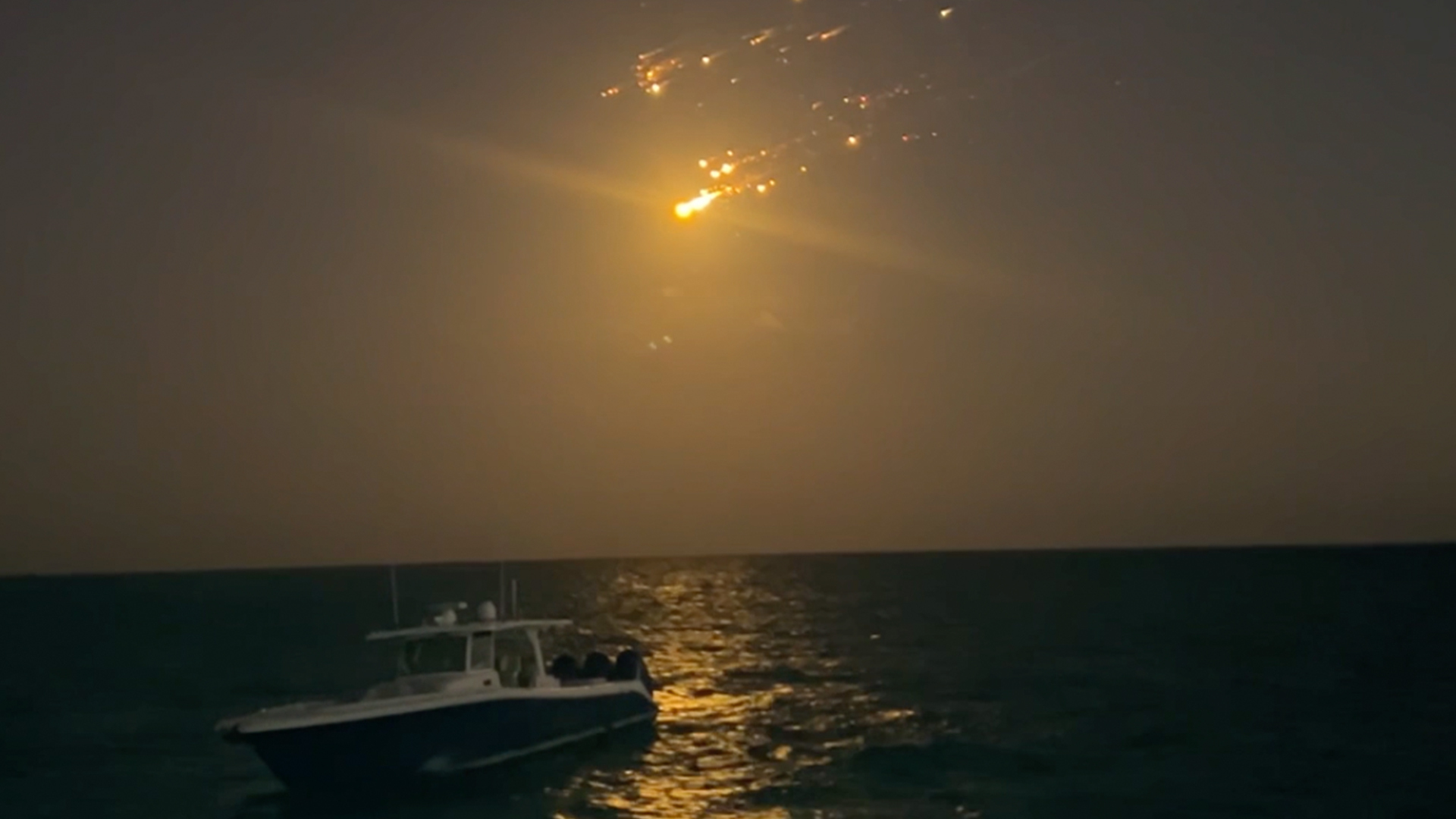Solar eclipse glasses: How to check safety and use them correctly
Protect your eyes as you watch this month's partial solar eclipse with our guide to purchasing safe and certified solar eclipse glasses.
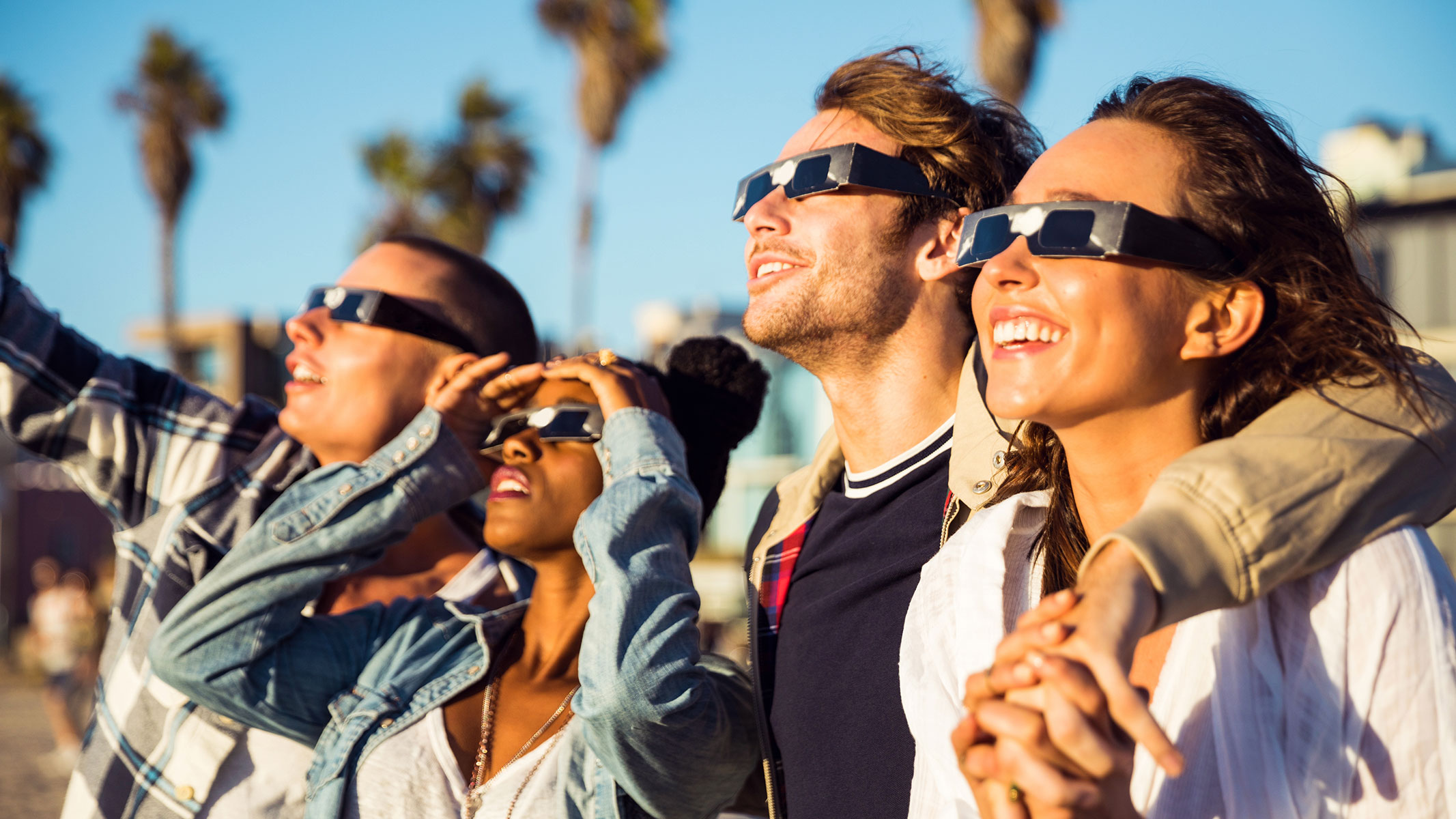
Eclipses are a truly spectacular phenomenon. On paper, they might not sound like much, one heavenly body blocking the light from another, but in person they can be breathtaking. And if you missed out on the recent lunar eclipse you'll be happy to hear that there's a partial solar eclipse happening this March 29.
The catch is that while you can look straight at a lunar eclipse, staring at a solar eclipse, even when the sun is partially obscured, is a bad idea. You can damage your eyesight, perhaps even permanently, which is why you need the proper protection for your eyes. That's why we've put together a guide explaining how to use solar glasses to view this and other future solar eclipses safely.
We also explain how to make sure that the glasses you purchase meet the appropriate safety standard. For alternative methods of viewing the partial solar eclipse in safety, take a look at our guide on observing the sun and our comprehensive guide to solar viewing gear, where we cover telescopes, binoculars and solar filters.
Solar eclipse glasses deals March 2025
- Amazon: Celestron solar eclipse glasses
- Target: Discounted ISO-certified solar eclipse glasses
- Walmart: ISO-certified solar eclipse glasses and smartphone filters
- Best Buy: Solar glasses, viewers, telescopes and binoculars
- B&H Photo Video: Single and multipack solar eclipse glasses
- Adorama: Solar eclipse glasses, telescope filters and binoculars
Regardless of the type of eclipse you're looking to view, it is essential that you use adequate eye protection whenever you look directly at the sun to avoid causing permanent and irreparable damage to your retinas.
While it might be tempting to pick up a cheap pair of solar-eclipse glasses from places like Amazon or eBay, this puts you at significant risk of buying unsafe or counterfeit glasses that won't provide your eyes with adequate protection. Instead, we recommend buying from one of the reputable sellers featured on this page, or from others that have been approved by the American Astronomical Society, to ensure that they meet current safety standards.
If you're interested in solar binoculars, telescopes or filter adapters be sure to check out our guide to the Best solar viewing kit for the solar eclipse.
Safety standards
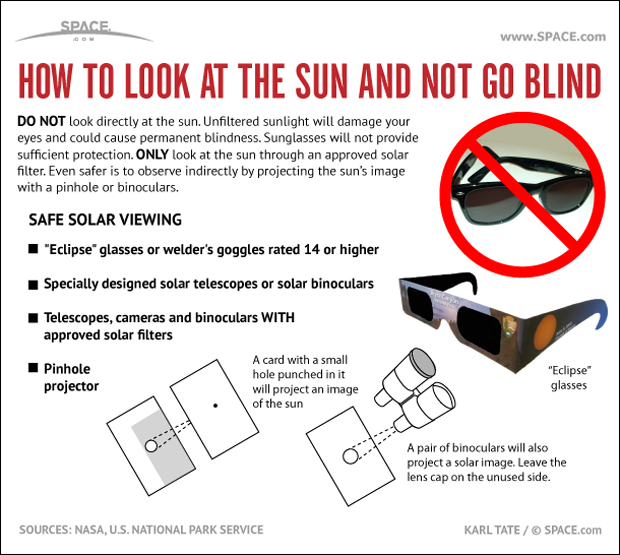
Wherever you buy from, it's extremely important to check the safety standards of any glasses you plan to use to view a solar eclipse. Even if a product looks like suitable solar eye protection, that doesn't mean that it's been designed to block out enough harmful radiation to keep your eyes safe when looking at the sun head-on (which is very different to just going outside on a sunny day).
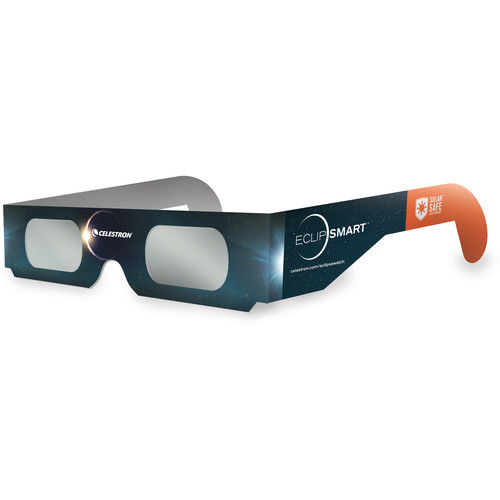
Available in a handy four-pack to kit out the whole family, these Celestron EclipSmart Solar Eclipse Glasses will keep you well protected while you view the eclipse.
It's best to look for a product that is labeled with 'ISO', which stands for the International Organization for Standardization.
The ISO is an independent organization that writes safety and quality standards for all kinds of things, including eyewear, health care, food production and more based on a broad consensus of the scientific community. If you find eclipse glasses or other solar viewers that aren't labeled 'ISO', then they aren't guaranteed to protect your eyes the way they should.
ISO-approved solar-eclipse glasses must meet certain safety requirements:
- No more than 0.00032 percent of the sun's light may be transmitted through the filters.
- The filters must be free of any defects, such as scratches, bubbles and dents.
- Handheld viewers must be large enough to cover both eyes.
- Labels on the viewers (or packaging) must include the name of the manufacturer, instructions for safe use and warnings of the dangers of improper use.

Where to find ISO-approved eclipse viewers
According to Rick Fienberg, press officer for the American Astronomical Society (AAS), most ISO-approved eclipse glasses use solar filters manufactured by AstroSolar and Thousand Oaks Optical. However, he did note that several different retailers sell eclipse glasses and handheld filters that are approved by the ISO.
The AAS has published a list of reputable vendors and manufacturers of eclipse glasses that includes Lunt Solar Systems, American Paper Optics and Rainbow Symphony.
Sunglasses simply won't do
Eclipse glasses and sunglasses might look somewhat similar, but they are made of very different materials. You should never look directly at the sun while wearing sunglasses, no matter how tinted your lenses may be.
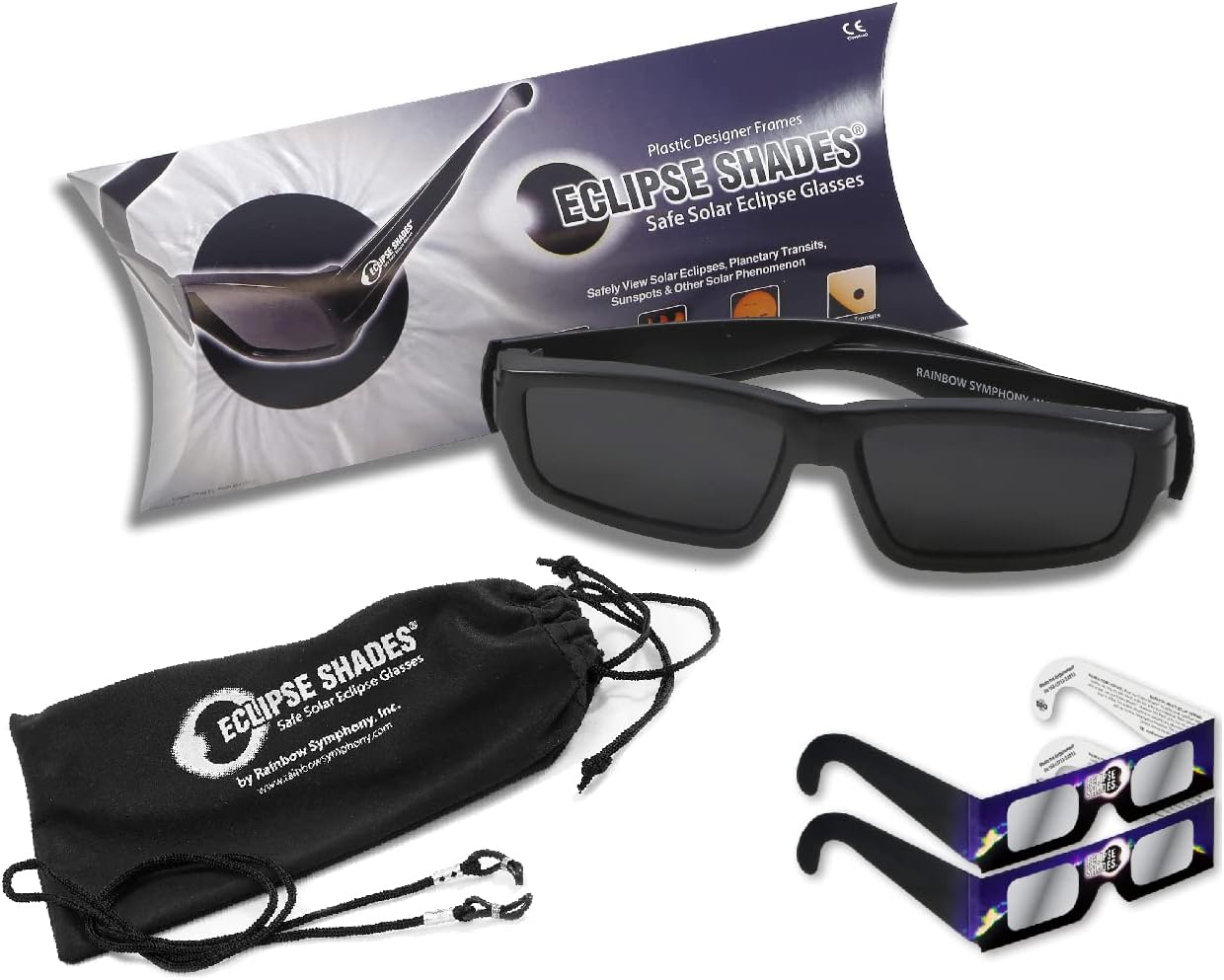
If you're after more of a sunglasses look, these Rainbow Symphony Plastic Eclipse Glasses are ISO certified and also come in a clip-on model for glasses wearers.
"Normal sunglasses typically let in between 10 and 20 percent of daylight… but that's still way too bright," Fienberg told Space.com. "The filters that are made for looking at the sun are typically 100,000 times darker."
Sunglasses tend to be made of glass, plastic or some kind of polycarbonate material, while solar filters are made of one of two materials: polyester film coated in aluminum, or something called 'black polymer', Fienberg explained. Most eclipse glasses and solar viewers use the black polymer, which is a flexible resin infused with carbon particles. Both types of filters will reduce visible light down to safe levels.
Welding goggles
Welders planning to observe the solar eclipse may or may not be in luck, as some welding filters will adequately protect your eyes from the sun. But, please, double-check to make sure that the goggles you intend to use are the right kind.
"There is a particular circumstance in which it's safe," Fienberg said. "We don't recommend it because it's too easy to get the wrong kind of welding filter." Only goggles made for electric arc welding can be used to observe the sun, and they must have a shade scale number of 12 or higher. Shade 13 is ideal for solar viewing, but that shade is typically not sold in stores, Fienberg added.
Chasing the next solar eclipse
The next two solar eclipses, due to take place in March and September 2025, will be partial solar eclipses. This means that the moon will pass across the sun, but the Earth, moon and sun will not be perfectly aligned, so it cannot block out the sun completely. Instead, the sun will appear similar to a crescent moon with a large chunk taken out the side of it. When viewing a partial solar eclipse, it's essential to keep your solar eclipse glasses on at all times to protect your eyes from the radiation given off by the remaining portion of the sun.
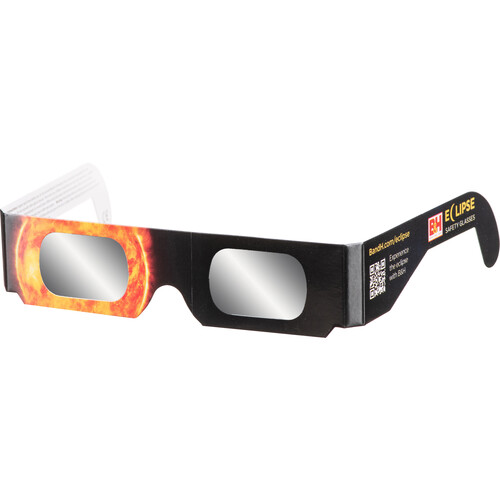
If you're planning your next solar eclipse on a tight budget, these American Paper Optics Solar Eclipse Glasses are a super-affordable option that doesn't compromise on safety.
But in 2026 the Earth will be treated to another total solar eclipse, when areas of Greenland, Iceland, Spain, Russia and Portugal will see the sun being completely blocked out by the moon. If you're lucky enough to catch a total solar eclipse within the narrow path of totality, then it is safe to remove your protective glasses only while the moon is fully obscuring the sun. "In fact, if you keep your filters on during totality, you won't see anything" because they block out almost all light," Fienberg said. Just be sure to check in advance how long the sun is projected to be completely obscured by the moon (which will usually only be for a few minutes at most) and replace your glasses as soon as the sun starts to reappear to avoid the risk of retinal damage.
This makes total solar eclipses particularly impressive. "A total solar eclipse is truly spectacular and awesome in the true meaning of the word 'awesome', whereas a partial solar eclipse could pass unnoticed," Fienberg said. "Even if you do have a solar filter and watch the sun turn into a thin crescent, it's nowhere near as exciting as a total eclipse, because you miss all the really spectacular phenomena that are associated with totality. It doesn't get dark, you don't see the corona, you don't see bright red prominences of gas jetting off from the edge of the sun. It's just not the same at all."
Editor's Note: If you snap an amazing picture of a solar eclipse, and would like to share it with Space.com's readers, send your photos, comments, and your name and location to spacephotos@space.com.
Join our Space Forums to keep talking space on the latest missions, night sky and more! And if you have a news tip, correction or comment, let us know at: community@space.com.
Get the Space.com Newsletter
Breaking space news, the latest updates on rocket launches, skywatching events and more!

Hanneke Weitering is a multimedia journalist in the Pacific Northwest reporting on the future of aviation at FutureFlight.aero and Aviation International News and was previously the Editor for Spaceflight and Astronomy news here at Space.com. As an editor with over 10 years of experience in science journalism she has previously written for Scholastic Classroom Magazines, MedPage Today and The Joint Institute for Computational Sciences at Oak Ridge National Laboratory. After studying physics at the University of Tennessee in her hometown of Knoxville, she earned her graduate degree in Science, Health and Environmental Reporting (SHERP) from New York University. Hanneke joined the Space.com team in 2016 as a staff writer and producer, covering topics including spaceflight and astronomy. She currently lives in Seattle, home of the Space Needle, with her cat and two snakes. In her spare time, Hanneke enjoys exploring the Rocky Mountains, basking in nature and looking for dark skies to gaze at the cosmos.
- Chris McMullenContributing Writer
- Rowena CockettContributing writer
